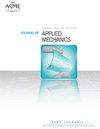Leveraging Dynamics-Induced Snap-Through Instabilities to Access Giant Deformations in Dielectric Elastomer Membranes
IF 2.8
4区 工程技术
Q2 MECHANICS
引用次数: 0
Abstract
Achieving extreme deformations without electrical breakdown has been a longstanding challenge in the dielectric elastomer community. In this paper, we present a novel approach for accessing giant in-plane stretches in circular dielectric elastomer membranes by leveraging nonlinear dynamics, specifically short-duration voltage pulses. These voltage pulses – applied about nominal bias voltages where the large-stretch equilibrium does not experience dielectric breakdown – create transient stretches that, if sufficiently large, cause the membrane to dynamically snap-through to its large-stretch equilibrium. These giant deformations are reversible; pulsed voltage drops can return the membrane from its large-stretch equilibrium to its small-stretch equilibrium. Parametric analyses are used to determine combinations of pulse amplitude and duration that result in snap-through. Corresponding through-thickness electric fields are shown to be below stretch-dependent dielectric strengths from the literature, suggesting practical feasibility. Unlike other techniques for accessing extreme stretches in dielectric elastomers, the present approach relies on voltage control alone; it therefore does not require altering the external mechanical forces that cause pre-stretch and can be applied without modifying the elastomer's mechanical compliance. This research demonstrates that carefully designed voltage pulses may permit existing and emerging soft material technologies to access extreme, large-stretch equilibria without dielectric breakdown.利用动态诱导的Snap-Through不稳定性来获取介电弹性体膜中的巨大变形
在电介质弹性体领域,实现无击穿的极端变形一直是一项长期挑战。在本文中,我们提出了一种新的方法,通过利用非线性动力学,特别是短持续时间的电压脉冲,来获得圆形介电弹性体膜中的巨大平面内拉伸。这些电压脉冲施加在大拉伸平衡不经历介电击穿的标称偏置电压附近,产生瞬态拉伸,如果足够大,会导致膜动态地快速达到其大拉伸平衡。这些巨大的变形是可逆的;脉冲电压降可以使膜从其大拉伸平衡返回到其小拉伸平衡。参数分析用于确定脉冲幅度和持续时间的组合,从而导致瞬变。相应的穿透厚度电场低于文献中的拉伸相关介电强度,这表明了实际的可行性。与用于获得介电弹性体中的极端拉伸的其他技术不同,本方法仅依赖于电压控制;因此它不需要改变引起预拉伸的外部机械力,并且可以在不改变弹性体的机械顺应性的情况下施加。这项研究表明,精心设计的电压脉冲可以使现有和新兴的软材料技术在没有介电击穿的情况下实现极端的大拉伸平衡。
本文章由计算机程序翻译,如有差异,请以英文原文为准。
求助全文
约1分钟内获得全文
求助全文
来源期刊
CiteScore
4.80
自引率
3.80%
发文量
95
审稿时长
5.8 months
期刊介绍:
All areas of theoretical and applied mechanics including, but not limited to: Aerodynamics; Aeroelasticity; Biomechanics; Boundary layers; Composite materials; Computational mechanics; Constitutive modeling of materials; Dynamics; Elasticity; Experimental mechanics; Flow and fracture; Heat transport in fluid flows; Hydraulics; Impact; Internal flow; Mechanical properties of materials; Mechanics of shocks; Micromechanics; Nanomechanics; Plasticity; Stress analysis; Structures; Thermodynamics of materials and in flowing fluids; Thermo-mechanics; Turbulence; Vibration; Wave propagation

 求助内容:
求助内容: 应助结果提醒方式:
应助结果提醒方式:


